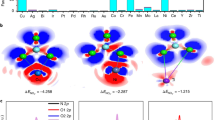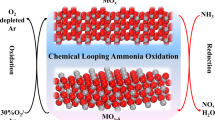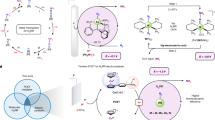Abstract
Industrially, the artificial fixation of atmospheric nitrogen to ammonia is carried out using the Haber–Bosch process, but this process requires high temperatures and pressures, and consumes more than 1% of the world's power production. Therefore the search is on for a more environmentally benign process that occurs under milder conditions. Here, we report that a Ru-loaded electride [Ca24Al28O64]4+(e−)4 (Ru/C12A7:e−), which has high electron-donating power and chemical stability, works as an efficient catalyst for ammonia synthesis. Highly efficient ammonia synthesis is achieved with a catalytic activity that is an order of magnitude greater than those of other previously reported Ru-loaded catalysts and with almost half the reaction activation energy. Kinetic analysis with infrared spectroscopy reveals that C12A7:e− markedly enhances N2 dissociation on Ru by the back donation of electrons and that the poisoning of ruthenium surfaces by hydrogen adatoms can be suppressed effectively because of the ability of C12A7:e− to store hydrogen reversibly.
This is a preview of subscription content, access via your institution
Access options
Subscribe to this journal
Receive 12 print issues and online access
$259.00 per year
only $21.58 per issue
Buy this article
- Purchase on Springer Link
- Instant access to full article PDF
Prices may be subject to local taxes which are calculated during checkout





Similar content being viewed by others
References
Mittasch, A. Early studies of multicomponent catalysts. Adv. Catal. 2, 81–104 (1950).
Honkala, K. et al. Ammonia synthesis from first-principles calculations. Science 307, 555–558 (2005).
Ertl, G. Elementary steps in heterogeneous catalysis. Angew. Chem. Int. Ed. Engl. 29, 1219–1227 (1990).
Gambarotta, S. & Scott, J. Multimetallic cooperative activation of N2 . Angew. Chem. Int. Ed. 43, 5298–5308 (2004).
Pool, A. J., Lobkovsky, E. & Chirik, P. J. Hydrogenation and cleavage of dinitrogen to ammonia with a zirconium complex. Nature 427, 527–530 (2004).
Spencer, N. D., Schoonmaker, R. C. & Somorjai, G. A. Structure sensitivity in the iron single-crystal catalyzed synthesis of ammonia. Nature 294, 643–644 (1981).
Aika, K., Takano, T. & Murata, S. Preparation and characterization of chlorine-free ruthenium catalysts and the promoter effect in ammonia-synthesis. 3. A magnesia-supported ruthenium catalyst. J. Catal. 136, 126–140 (1992).
Jacobsen, C. J. H. et al. Catalyst design by interpolation in the periodic table: bimetallic ammonia synthesis catalysts. J. Am. Chem. Soc. 123, 8404–8405 (2001).
Ozaki, A. Development of alkali-promoted ruthenium as a novel catalyst for ammonia synthesis. Acc. Chem. Res. 14, 16–21 (1981).
Tsai, M. C., Seip, U., Bassignana, I. C., Kuppers, J. & Ertl, G. A vibrational spectroscopy study on the interaction of N2 with clean and K-promoted Fe(111) surfaces: π-bonded dinitrogen as precursor for dissociation. Surf. Sci. 155, 387–399 (1985).
Rosowski, F. et al. Ruthenium catalysts for ammonia synthesis at high pressures: preparation, characterization, and power-law kinetics. Appl. Catal. A 151, 443–460 (1997).
Bielawa, H., Hinrichsen, O., Birkner, A. & Muhler, M. The ammonia-synthesis catalyst of the next generation: barium-promoted oxide-supported ruthenium. Angew. Chem. Int. Ed. 40, 1061–1063 (2001).
Rao, C. N. R. & Rao, G. R. Nature of nitrogen adsorbed on transition metal surfaces as revealed by electron spectroscopy and cognate techniques. Surf. Sci. Rep. 13, 221–263 (1991).
Aika, K., Ozaki, A. & Hori, H. Activation of nitrogen by alkali-metal promoted transition-metal. 1. Ammonia synthesis over ruthenium promoted by alkali-metal. J. Catal. 27, 424–431 (1972).
Hansen, T. W. et al. Atomic-resolution in situ transmission electron microscopy of a promoter of a heterogeneous catalyst. Science 294, 1508–1510 (2001).
Ertl, G. Reactions at surfaces: from atoms to complexity (Nobel Lecture). Angew. Chem. Int. Ed. 47, 3524–3535 (2008).
Urabe, K., Aika, K. & Ozaki, A. Activation of nitrogen by alkali metal-promoted transition metal. J. Catal. 38, 430–434 (1975).
Ommen, J. G., Bolink, W. J., Prasad, J. & Mars, P. The nature of the potassium compound acting as a promoter in iron–alumina catalysts for ammonia synthesis. J. Catal. 38, 120–127 (1975).
Larichev, Y. V. et al. XPS and TEM studies on the role of the support and alkali promoter in Ru/MgO and Ru-Cs+/MgO catalysts for ammonia synthesis. J. Phys. Chem. C 111, 9427–9436 (2007).
Siporin, S. E. & Davis, R. J. Use of kinetic models to explore the role of base promoters on Ru/MgO ammonia synthesis catalysts. J. Catal. 225, 359–368 (2004).
Bécue, T., Davis, R. J. & Garces, J. M. Effect of cationic promoters on the kinetics of ammonia synthesis catalyzed by ruthenium supported on zeolite X. J. Catal. 179, 129–137 (1998).
Dye, J. L. Electrides: early examples of quantum confinement. Acc. Chem. Res. 42, 1564–1572 (2009).
Matsuishi, S. et al. High-density electron anions in a nanoporous single crystal: [Ca24Al28O64]4+(e−)4 . Science 301, 626–629 (2003).
Sushko, P., Shluger, A., Hayashi, K., Hirano, M. & Hosono, H. Electron localization and a confined electron gas in nanoporous inorganic electrides. Phys. Rev. Lett. 91, 126401-1-4 (2003).
Toda, Y., Kubota, Y., Hirano, M., Hirayama, H. & Hosono, H. Surface of room-temperature-stable electride [Ca24Al28O64]4+(e−)4: preparation and its characterization by atomic-resolution scanning tunneling microscopy. ACS Nano 5, 1907–1914 (2011).
Hayashi, K. Heavy doping of H− ion in 12CaO·7Al2O3 . J. Solid State Chem. 184, 1428–1432 (2011).
Kim, S-W. & Hosono, H. Synthesis and properties of 12CaO·7Al2O3 electride: a review of single crystal and thin film growth. Phil. Mag. 92, 2596–2628 (2012).
Yoon, B. et al. Charging effects on bonding and catalyzed oxidation of CO on Au8 clusters on MgO. Science 307, 403–407 (2005).
Ricci, D. et al. Paramagnetic defect centers at the MgO surface. An alternative model to oxygen vacancies. J. Am. Chem. Soc. 125, 738–747 (2003).
Sushko, P. V., Gavartin, J. L. & Shluger A. L. Electronic properties of structural defects at the MgO (001) surface. J. Phys. Chem. B 106, 2269–2276 (2002).
Toda, Y. et al. Work function of a room-temperature, stable electride [Ca24Al28O64]4+(e−)4 . Adv. Mater. 19, 3564–3569 (2007).
Michaelson, H. B. The work function of the elements and its periodicity. J. Appl. Phys. 48, 4729–4733 (1977).
Matsuishi, S. et al. Direct synthesis of powdery inorganic electride [Ca24Al28O64]4+(e−)4 and determination of oxygen stoichiometry. Chem. Mater. 21, 2589–2591 (2009).
Liang, C., Wei, Z., Xin, Q. & Li, C. Ammonia synthesis over Ru/C catalysts with different carbon supports promoted by barium and potassium compounds. Appl. Catal. A 208, 193–201 (2001).
Kowalczyk, Z. et al. Carbon-supported ruthenium catalyst for the synthesis of ammonia. The effect of the carbon support and barium promoter on the performance. Appl. Catal. A 184, 95–102 (1999).
Raróg-Pilecka, W. et al. Carbon-supported ruthenium catalysts for NH3 synthesis doped with caesium nitrate: activation process, working state of Cs–Ru/C. J. Catal. 239, 313–325 (2006).
Kadowaki, Y. & Aika, K. Promoter effect of Sm2O3 on Ru/Al2O3 in ammonia synthesis. J. Catal. 161, 178–185 (1996).
Kubota, J. & Aika, K. Infrared spectra of adsorbed dinitrogen on ruthenium metal supported on alumina and magnesium oxide. J. Chem. Soc. Chem. Commun. 1544–1545 (1991).
Kubota, J. & Aika, K. Infrared studies of adsorbed dinitrogen on supported ruthenium catalysts for ammonia synthesis: effects of the alumina and magnesia supports and the cesium compound promoter. J. Phys. Chem. 98, 11293–11300 (1994).
You, Z., Inazu, K., Aika, K. & Baba, T. Electronic and structural promotion of barium hexaaluminate as a ruthenium catalyst support for ammonia synthesis. J. Catal. 251, 321–331 (2007).
Aika, K. et al. Support and promoter effect of ruthenium catalyst. Ш. Kinetics of ammonia synthesis over various Ru catalysts. Appl. Catal. A 28, 57–68 (1986).
Hagen, S. et al. Ammonia synthesis with barium-promoted iron–cobalt alloys supported on carbon. J. Catal. 214, 327–335 (2003).
Acknowledgements
We deeply appreciate K. Aika for his suggestions. Discussions with K. Nakajima and Y. Toda are acknowledged. We thank T. Yoshizumi, S. Nakamura and D. Lu for their technical assistance. This work was supported by a Funding Program for World-Leading Innovative R&D on Science and Technology from the Japan Society for the Promotion of Science. A part of this work was supported by a fund from the Element Strategy Initiative Project of the Ministry of Education, Culture, Sports and Science for Technology in Japan.
Author information
Authors and Affiliations
Contributions
H.H. proposed the idea behind this research and M.H. and H.H. directed the entire project. M.K., Y.I., Y.Y., F.H., S.M., S.K., T.Y. and S-W.K. performed the synthesis, characterization and catalytic testing of Ru/C12A7:e−. All the authors discussed the results and commented on the study. M.K., M.H. and H.H. co-wrote the manuscript.
Corresponding authors
Ethics declarations
Competing interests
The authors declare no competing financial interests.
Supplementary information
Supplementary information
Supplementary information (PDF 809 kb)
Rights and permissions
About this article
Cite this article
Kitano, M., Inoue, Y., Yamazaki, Y. et al. Ammonia synthesis using a stable electride as an electron donor and reversible hydrogen store. Nature Chem 4, 934–940 (2012). https://doi.org/10.1038/nchem.1476
Received:
Accepted:
Published:
Issue Date:
DOI: https://doi.org/10.1038/nchem.1476
This article is cited by
-
Anionic Defects Enhanced Ammonia Synthesis Over Ru Catalyst Supported on Barium Niobate Reduced with CaH2
Catalysis Letters (2024)
-
Optimization of Ruthenium Particle Size and Ceria Support for Enhanced Activity of Ru/CeO2 Cluster Catalysts in Ammonia Synthesis Under Mild Conditions
Catalysis Letters (2024)
-
V2O4 Nanowires/rGO Hybrid for Electrocatalytic Nitrogen Fixation
Catalysis Letters (2024)
-
Converting N2 molecules into NH3 with TiO2/Fe3O4 composite covered with a thin water layer under ambient condition
Scientific Reports (2023)
-
Magnetic quasi-atomic electrons driven reversible structural and magnetic transitions between electride and its hydrides
Nature Communications (2023)



